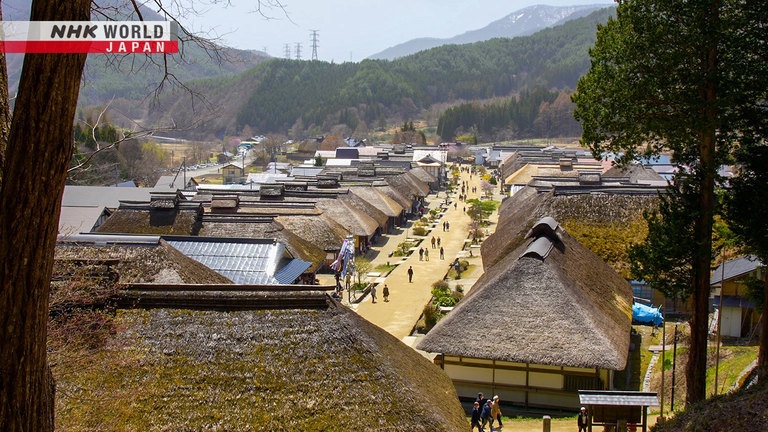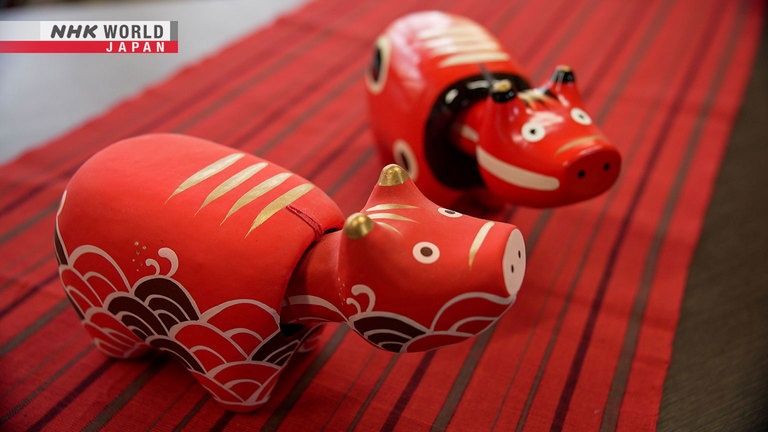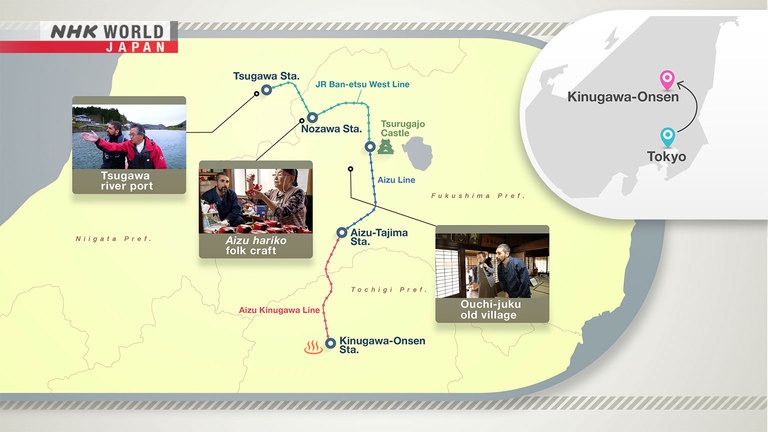With Isabella Bird — Part 2: On the Road to Tsugawa
British explorer and writer Isabella Bird arrived in Japan in 1878, a mere 10 years after the country opened its doors to the West. Accompanied by just one young man who served as both her interpreter and attendant, she traveled deep into the hinterland. Unbeaten Tracks in Japan is her highly praised travelogue of that journey. It is a valuable record written from the perspective of a devout Christian endowed with critical thinking, which smashed the fairytale image of Japan that had spread in Western countries. On this episode of Journeys in Japan, US writer Benjamin Boas traces Bird's footsteps, looking for vestiges of the Japan of 150 years ago. Starting from Kinugawa Onsen, he makes his way to the Aizu region and then to the town of Tsugawa, in Niigata Prefecture.
Ouchi-juku (Historic Post Town)

Like a time capsule from the Edo period, the thatched-roof buildings in this former post town remain virtually untouched since the days when Isabella Bird stayed there.
Aizu Hariko (Local Papier-mâché Folk Craft)

This traditional folk craft dating back to the Edo period is known for its iconic akabeko (toy cows), which are believed to bring good luck, especially for new-born babies.
Tsugawa (River Port Town)

This town was formerly a hub for goods shipped by boat to and from the Sea of Japan coast. It is also the place of origin for a traditional architectural style known as gangi, using wooden boards under the eaves of the houses to prevent snow from coming in.
Access

From Tokyo, trains to Kinugawa Onsen take about three hours. To reach the Aizu area and Tsugawa, you can use the local train or bus services.
Transcript
"Journeys in Japan"
"We rode for some time within hearing of the Kinugawa,"
"catching magnificent glimpses of it frequently-"
"turbulent and locked in by walls of porphyry,"
"or widening and calming and spreading its aquamarine waters"
"over great slabs of pink and green rock,"
"lighted fitfully by the sun, or spanned by rainbows,"
"or pausing to rest in deep shady pools,"
"but always beautiful."
That was a description of how the Kinugawa River looked 140 years ago
and it's still beautiful today.
The person who wrote those words was Isabella Bird,
an English explorer who departed from Yokohama
and moved up to Nikko.
This time, we're going to be following her footsteps
using her book as a guide as we travel to Tsugawa.
Let's see what's waiting for us.
Tracing the Japan that Isabella Bird glimpsed 140 years ago...
- So she stayed in this room?
- That's right.
You can see the "gangi" she mentioned.
I remember she wrote about them.
On this edition of "Journeys in Japan,"
writer Benjamin Boas follows in the footsteps of Isabella Bird,
looking for vestiges of those early days,
soon after Japan opened up to the world.
With Isabella Bird, Part 2: On the Road to Tsugawa
The starting point for today's journey
is Kinugawa-onsen, in Tochigi Prefecture,
around 120 kilometers north of Tokyo.
This hot spring resort in the city of Nikko
was first discovered more than 300 years ago.
For a long time, only feudal lords and priests were allowed to bathe here.
The hot spring was only opened to the public after the Meiji era began.
Although there were few buildings when Bird visited,
before long, large inns sprang up
and it grew into a popular tourist spot.
But due to the effects of the bursting of Japan's economic bubble,
tourism started to decline.
It's on the rise again though
thanks to the boom in inbound international tourism.
This is Isabella Bird's book
which Benjamin is using as a guide for his trip.
Called "Unbeaten Tracks in Japan,"
she wrote it in the form of letters home to her sister.
Bird was born in the county of Yorkshire, in northern England.
She was 47 when she arrived in Japan.
She also went on to visit other parts of Asia
and the Middle East.
Setting out from Yokohama,
she spent three months traveling first to Nikko,
then to Niigata, Akita and eventually Hokkaido.
Later, she visited western Japan,
in all staying in the country over half a year.
From Nikko, Bird's route took her across to Niigata,
via the Aizu region.
Benjamin's plan is to follow her route
as far as the town of Tsugawa.
(Aizu Nishi Kaido highway)
There's one place I'd like to see before we head out.
Here it is.
This roadside inn built in 1868 stood in the post town of Fujiwara-juku,
on the old highway.
Now it's preserved in a nearby park.
The main part of the house and the stable share the same roof.
This lodging was often used by itinerant traders.
"The 'yadoya' consisted of a 'daidokoro,'"
"or open kitchen, and stable below,"
"and a small loft above, capable of division"
In her book, Isabella wrote about staying in a yadoya.
It must have looked just like this.
And that must be the stable in there.
I wonder how many horses fit in.
Are you my guide?
My name is Otsuka. I study the history of this area.
Was this the stable?
These days it's a showcase for the artifacts.
But in the old days three or four horses were kept here.
People liked to keep their horses inside
so they could always keep an eye on them.
- The horses were very important?
- Yes.
As many as ten people at a time would be lodging here.
It was a popular and prosperous inn.
From Nikko onward, Bird mostly rode on horseback.
She writes that she was often helped by others
traveling with horses on the road.
In her book,
she praises those people for their honesty and also their kindness.
Bird writes that people's living conditions were bad,
and so was their hygiene.
Water was scarce in this upland area.
Another reason was the Boshin War.
The fighting was fierce in this area
and most of the post towns were burned down.
The Fujiwara district was entirely destroyed.
The situation was still very difficult for people.
- The whole village?
- Yes, everything.
In 1868, fighting broke out between the forces of the Tokugawa Shogunate
and those supporting the Emperor Meiji.
Known as the Boshin War, the conflict continued for a year.
There were battles from Kyoto to as far north as Hokkaido,
and many areas were devastated.
This happened just ten years before Bird's arrival in Japan.
Bird writes explicitly about the desperate conditions
that people were living in.
She was keen to see them helped.
(Kinugawa, Shiraiwa Peninsula)
"Kisagoi, a small upland hamlet, a very poor place,"
"with poverty-stricken houses,"
"children very dirty and sorely afflicted by skin maladies,"
"and women with complexions and features hardened by severe work"
"and much wood smoke into positive ugliness,"
"and with figures anything but statuesque."
"I write the truth as I see it."
"But truly this is a new Japan to me;"
"of which no books have given me any idea, and it is not fairyland."
(Lake Ikari)
Bird's next destination was Tajima, in the Minamiaizu region,
part of Fukushima Prefecture.
The Aga River runs through the town,
flowing down towards the Japan Sea.
Isabella crossed the river behind me using a small boat.
You might be wondering how she picked this path.
She asked many people, and she also was carrying a map.
This was a map that was commonly used around the time Bird was in Japan.
She carried a map like this with her on her expedition.
"So after much study of Brunton's map,"
"I have fixed upon one place,"
"and have said positively, 'I go to Tajima.'"
"If I reach it I can get farther, but all I can learn is,"
"'It's a very bad road, it's all among the mountains.'"
From Nikko, Bird made her way along steep mountain roads,
finally arriving in Minamiaizu.
She writes that "the map is blank in this region."
She was heading for Tajima based on the scanty details available to her.
(Tajima)
After passing through the area Isabella recorded her experiences.
She wrote, the country was really very beautiful.
The views were wider and finer.
And she mentioned the clustered peaks.
This post town, Ouchi-juku,
lies about 25 kilometers from Tajima.
Bird only mentions the name briefly.
But today, around 150 years later,
it's become quite well known in Japan.
The Edo period townscape has been left virtually intact,
preserved almost like a time capsule.
With the opening of railroads, foot traffic along this road ceased.
And for years, there were few interactions with the outside world.
Excuse me. Is this where Isabella Bird stayed?
Yes, this is it.
- May I look inside?
- Please come in.
The Minoya Inn is the place where Isabella Bird stayed.
It's still the residence of the Abe family,
but they do allow visitors to view some of the rooms.
So she stayed in this room?
That's right.
I see. What was it like for her staying here?
The story has been passed down that
no one had seen a foreign woman before...
So people poked holes in the paper of the "shoji" doors to peek at her.
"I slept at a house combining silk farm, post office, express office,"
"and 'daimiyo's' rooms, at the hamlet of Ouchi"
This looks like an old candle holder.
It has been in our family for generations.
Then perhaps Bird might have used it.
Maybe.
It's been left just the way it was.
That helps to give us a sense of what it was like
when she stayed here.
At one point, the thatched roofs that
Bird would have seen were in danger of disappearing.
During the 1970s,
many house owners started replacing them with metal roofs.
At the time, the people living here were divided
between those in favor of preserving the townscape and those opposed.
It took several years before a consensus arose
to keep the old buildings intact.
Now, young people here are learning the techniques of thatching,
so they can carry on the tradition.
How many years does it take to learn thatching?
I had to train for a couple of years
before starting to work on an actual thatched roof.
But I'm still learning.
Do you replace the whole roof?
In the past, the entire roof would be rethatched.
But now we just repair the damaged bits.
It must require a lot of people.
For situations like rethatching our houses,
we draw on the traditional "yui" system.
Most Japanese villages had a system of cooperation, known as yui,
whereby the local people come together to help
when many hands are needed for major tasks.
In Ouchi-juku, when someone helps you,
you return the favor with your own labor.
That way we always have enough hands.
- It sounds like a bank for labor.
- That's right!
Except we don't get much interest!
All of us grew up here in Ouchi-juku
but we left for university or to find work.
We returned to run our family tourist businesses,
and we also began learning the thatching skills.
That's good.
I'm glad another generation is being educated in the yui system.
The Aizu Basin lies about 20 kilometers north of Ouchi-juku.
Avoiding the castle town of Aizuwakamatsu,
Isabella Bird made her way to the west side of the basin.
She is thought to have taken this route
because the damage from the Boshin War was still very fresh in the town.
The fighting was so intense,
in this area the conflict came to be known as the Aizu War.
Aizuwakamatsu's iconic castle was severely damaged by cannon fire,
and several thousand people lost their lives.
(Tsurugajo Castle)
Isn't this tree beautiful? It's been around for 300 years.
Isabella came near this very tree as she continued her way up north.
At this point, crowds were forming to come and see the famous explorer
and Isabella was getting a little bit tired,
but she did write that she was able to observe some "washi" paper making
at a nearby farmhouse,
and she enjoyed the experience.
This area is known for a papier-mache folk craft called "Aizu hariko,"
especially this toy cow, known as "akabeko."
Today, the tradition of producing washi has almost disappeared in Aizu,
but the papier-mache folk craft remains alive.
This workshop is located in the Nozawa district of Nishiaizu Town,
a place that Bird passed through.
These are cute. How do you make them?
In the past, we glued washi onto a wooden base.
But now we make the base in molds,
using recycled paper dissolved in water.
Only from recycled paper and water?
That's very eco-friendly.
Is the design the same as in the old days?
The basic shape is unchanged.
- So, you don't make any new designs?
- We do.
We make new designs but also continue the old ones.
Wonderful! You're preserving the tradition
while also making new products.
As it is no longer covered with washi paper,
the process is a bit shorter now.
Even so, because everything is done by hand,
it takes about four days to complete.
Aizu hariko was introduced here 350 years ago.
The local lord at that time brought a doll maker from Kyoto
and he instructed the lower-ranking samurai to learn the craft,
as a way to make a living.
The traditional red akabeko cow is a good luck charm,
and has long been given to babies when they are born.
Recently, a new design in blue has also become popular.
What inspired you to make this new pattern?
The 2011 Great East Japan Earthquake
gave rise to many new things in this area.
Things that help to boost people's spirits.
So you're creating a new path in this long tradition?
As long as concept and your feeling towards it remain unchanged...
I think it will become a new tradition,
even if the way you make it changes.
(Isabella headed west on the Echigo Kaido highway.)
(These days, the narrow mountain trail has gone,)
(replaced by roads with busy traffic.)
Tsugawa lies in Niigata Prefecture.
To reach it, Bird had to travel on horseback and on foot,
along the rugged Echigo Kaido highway.
From here, the Aga River changes its name
to the "Agano River."
During the Edo period, Tsugawa was a prosperous town.
Downstream from this point, the river is navigable.
So, goods could be transported by boat, instead of on horseback.
Rice and lumber were shipped down from the Aizu region,
and seafood and salt were carried upstream from Niigata.
"Thatch, with its picturesqueness, has disappeared,"
"and the Tsugawa roofs are of strips of bark weighted with large stones"
This is the site of the "honjin" (official inn).
The building is different now,
but this is the location where Isabella Bird is said to have stayed.
I see.
The actual structure has been rebuilt,
but you can still see the gangi she mentioned.
That's right she wrote about those features.
The eaves of the houses here were joined together
to form corridors that kept out the heavy snow.
Known as gangi,
this architectural style is said to have originated in Tsugawa.
Boards were placed between the pillars
to form a corridor that stops the snow from coming in.
It's the communal spirit of the snow country.
That's right.
"The house-master's wife and Ito talked about me unguardedly."
"I asked what they were saying."
"'She says,' said he,"
"'that you are very polite - for a foreigner,' he added."
Isabella Bird enjoyed a relaxed stay at an inn here,
waiting for the regular ferry service down to Niigata.
So, Mr. Usuki had said that
this was the place where Isabella had to run down
because they had to leave on an early boat.
"The boat for Niigata was to leave at eight,"
"but at five Ito roused me by saying they were going at once,"
"as it was full, and we left in haste..."
"the house-master running to the river with one of my large baskets"
"on his back to 'speed the parting guest.'"
I think that it's right around here.
Oh yeah, that's where it must've been.
That's where they left from. Look at that.
It's still here.
Beginning in the Meiji era, mines were developed in this region
and roads and railroads were built alongside the Agano River.
A dam was also constructed,
so the swift current that Bird would have seen has now disappeared.
Even so, there is beautiful scenery to be enjoyed along the river.
When boats for tourism go down the river in Japan,
they call it "ra-in kudari."
Kudari means going down
and the origin of the "ra-in" term
might have actually been the Rhine River in Germany
which Isabella writes about.
"Pinnacles and needles of bare, flushed rock"
"rose out of luxuriant vegetation-"
"Quiraing without its bareness,"
"the Rhine without its ruins, and more beautiful than both."
This leg of the journey began with a river, and it ends with a river.
Isabella wrote about the beautiful scenery that she saw
but as she put it, Japan is not fairyland
and that even though some readers
might not like the descriptions that she was saying,
she wrote it to contribute to the general knowledge of the world.
Just like her,
I saw beautiful scenery, wonderful people, amazing culture,
but I also noticed that some of these regions are encountering difficulties
as Japan continues to move into the 21st century.
If you'd like to help out, I encourage you to come.
Tourism is one great way to revitalize these localities.
Maybe it's time for you to make Isabella's journey your own.
From Tokyo, trains to Kinugawa-onsen take about three hours.
To reach the Aizu area and Tsugawa,
you can use the local train or bus services.